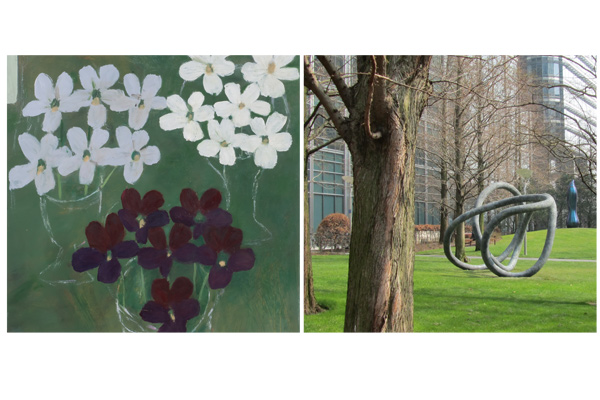Alexander Calder (1898–1976) needs no introduction. The master of the mobile — that poignant hanging arrangement of moving elements — he also invented the stabile (stationary) and the standing mobile. There was no one who could cut and shape sheet aluminium and suspend it from wire with quite the same wit, economy and shape invention. His imagery is primarily abstract and organises flat geometrical forms in contrasting planes through space: discs and triangles balance more biomorphic shapes and are linked by bent sprung wire into a multidirectional kinetic experience of colour and light. Calder mostly used black, white and red, supplemented with blue and yellow, his forms poised and counterweighted with supreme grace and the kind of intricacy that demands utter clarity. A good show of his work is a visual and intellectual delight — and this exhibition could scarcely be bettered.
It focuses on the paintings and sculptures that Calder made in one of the most fertile periods of a productive career, 1945 to 1949. The downstairs gallery in Burlington Gardens, at the back of the Royal Academy (where the last substantial Calder exhibition was mounted in 1992), is filled with the most dazzling array of three-dimensional form, light as thistledown, beautifully tempered in its tensile rigidity. There’s a lot of work here, but in this bright white space it doesn’t look crowded: it has been so expertly installed that the disposition of the sculptures looks as natural as breathing. The rigours of engineering (that sheer precision) meet humour: the masks and petals, the quivery ‘Aspen’ (1948), the arcing ‘Sword Plant’ (1947) and the egregious and wonderfully whiskery ‘Rat’ (1948). The smallish ‘Horse and Rider’ and the cigar-box miniatures of ‘Louisa’s 43rd Birthday Present’ contrast with the aerial grace of ‘Snow Flurry’, one of my favourite pieces here.
Upstairs, in Pace’s newly renovated first-floor gallery, a display of Calder’s bright and playful paintings is altogether less impressive but certainly worth viewing — particularly a group of small untitled gouaches from 1949. But it is the sculpture that takes the ludic to new heights of exquisite seriousness: breathtaking.
Eilís O’Connell (born 1953) is a very different kind of sculptor, who uses a wide range of materials and finds inspiration equally among the man-made and the organic. In the past she has fashioned shell-like forms out of woven stainless-steel cable or a nest from goose feathers; her latest work, on show at Canary Wharf, ranges from bronze to resin in a rich and satisfying vein of invention. Outside, in the small but popular Canary Wharf Park, where office workers congregate to smoke, lunch and chat, and young mothers bring their children to play in the spring sunshine, there are five substantial O’Connell pieces dotted around the grassy hummocks. ‘Anodos’ (2010) is like a stylised flame or tear drop, its deeply waisted vertical form in metallic bluey-green polyester resin has a sparkling, candescent quality, the colour shifting as you walk around it, your shadow distorting the surface reflections in a hall-of-mirrors way. It looks like a rather solid ignis fatuus, the will-o’-the-wisp or marsh gas exhalations that burn eerily of their own accord on boggy ground.
‘Circuit’ (2011), by contrast, is a rolling swirl of pipe in textured grey, an elegant bit of three-dimensional drawing. Two other pieces are strongly reminiscent of Henry Moore — nothing wrong with that, he’s a sculptor to revere — though exerting their own independence of character at the same time. ‘Sacrificial Anode’ (2007), in cast bronze, has anatomical qualities, recalling the curve of hip and haunch and belly, yet it doubles back on itself like some kind of hook or clasp. It’s a lovely form with a smooth tactile surface crying out to be caressed. (One big advantage of sculpture in the open air: you can touch it.) ‘Slope’ (2011) is a chunky slab of resin, a miniature mountain with lovely lines that reveal themselves as you walk around it and the form moves, swelling out from a crisp edge. I nearly missed the fifth piece, a tall bronze slice of tree called ‘Atlantic Oak’ (2013), presented bark outwards, standing like a sentinel or lightning-struck totem in the grass.
In the foyer of nearby 1 Canada Square is a group of smaller sculptures, including a tear drop and a pebble in clear resin and some small bronzes with striking patinas. The most beautiful of these is ‘Cronody’, an invented form a little like the skull of a bird, infinitely preferable to ‘Meniscus’, which looks rather too like a bedpan to earn my wholehearted approval. There are various found objects embedded in clear resin, a sheep skull, a vulture feather, a whalebone, and a number of larger, grouped, standing sculptures. The most memorable of these have conical bodies and a single proboscis or feeler emerging more or less vertically from them, like a plant shoot or a long thin tongue.
The title of one of these forms in a smaller version, ‘Gourd Elongated’, indicates one organic source of imagery. O’Connell’s work is strange, various and intriguing: Irish-born, she lived in London from 1988 to 2001 before returning to Ireland and settling in County Cork. An artist of originality and vision, she deserves to be more widely recognised.
Another original was the painter Mary Newcomb (1922–2008). How to describe her work? The nearest I can get is this: poetic realism of extraordinary oddness and gentle lyricism, which lodges in the mind and radiates sensations of quiet revelation and benign surprise. At her best — and there are a number of very fine examples in the current show by her long-time dealers Crane Kalman — Newcomb is utterly beguiling. She takes a subject as seemingly neutral as a black-and-white house in a field at the end of a day. Into the warm apricot sky she streaks some sunset colour behind the chimneypots, reminiscent of a flag or a rainbow, and the magic sets in. To the left of the house is a three-storey hen coop (how do the chickens get out of their high rise?), to the right a minuscule water tower. At the top corners of the painting are grey-black castors on wires, four on the left, two on the right, which echo another four on the left-side back of the house. Although not visibly joined by cables, these are presumably telephone connections. There are trees, also dwarfed — like everything else — by the house, and finally one notices two tiny figures near the very front of the picture, almost lost amid the lush and joyful patterning of meadow: a black cat and a white and black cat.
Clearly Newcomb’s vision is firmly rooted in observation, but the way she combines and reinterprets what in other hands would look trite becomes under her shaping intelligence unique. Not to be missed.






Comments